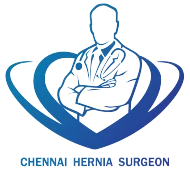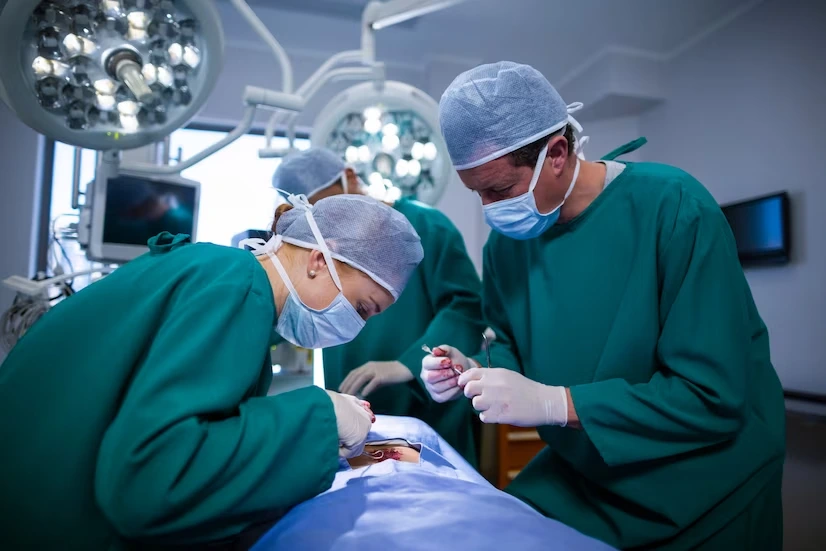A surgical procedure used to deliver a baby by making incisions in the abdomen and uterus is called a C-section. It is, like other surgeries, a common and safe process but may have some risks. One of the risks is hernia development. It can happen in the surgical incision area or other areas in the abdomen. It can cause complications and discomfort if not addressed.
This blog provides details regarding the hernia types related to C-sections. Along with symptoms, diagnoses, treatments, and prevention methods. This can help you get an understanding of hernia and C-sections.
Table of Contents
ToggleTypes of Hernias Associated with C-sections
The types of hernias after C-section are classified into two types, namely incisional and umbilical hernias. Both types happen because of the strain in the abdominal wall during pregnancy and surgery.
Incisional hernia after c-section
The hernia happens at the area of the surgical incision made at the C-section. This type of hernia occurs when the tissues around the incision become weak, thus allowing the intestinal part or contents of the abdomen to push through. Incisional hernia differs in severity and size, as some may need surgery others do not.
The risk of incisional hernia after a C-section is higher in women who have undergone multiple C-sections or experienced complications during or after surgery. Factors such as poor healing, infection, or engaging in excessive physical activity during the recovery period can also increase the likelihood of developing an incisional hernia.
Umbilical hernia after c-section
When a portion of the intestine of fatty tissues pushes around the abdominal wall, an abdominal hernia occurs. Umbilical hernias are common in infants, but they can also occur in adults, especially those who have gone through pregnancies and C-sections. It is mainly due to the increased pressure on the abdomen during pregnancy, as it weakens the abdominal walls, leading to hernias.
Umbilical hernia symptoms may vary depending on the size of the hernia. Smaller umbilical hernias often do not cause noticeable symptoms, while larger hernias can lead to discomfort, pain, or complications such as strangulation. In such cases, surgery may be required to address the issue.
Causes for Developing a Hernia After C-section
There are various factors associated with causing hernia after a C-section. Some are:
Surgical incision: the incision during C-section may cause a hernia as it weakens the abdominal walls.
Increased pressure in the abdomen: naturally, pregnancy may increase abdominal pressure because of stretching and weakening of abdominal walls. This may lead to a hernia, mainly if the muscles in the abdomen do not fully recover after childbirth.
Multiple C sections: women undergoing multiple C sections have an increased risk of hernia as the repeated incision may weaken the abdominal muscles.
Poor healing or infection: the abdominal wall’s integrity may be compromised if the site of incision has poor healing or if there is an infection.
Physical strain: if a woman is engaging in strenuous activities after a C-section, it can strain the abdominal walls, and the risk of hernia increases.
Pre-existing History: if the woman had a history of abdominal hernia, then after the C-section the risk of hernia increases.
Symptoms of Hernia after C-Section
The most evident symptoms of hernia will manifest themselves; other symptoms will be shown as body reactions to hernia. Hernia after C-section has symptoms like:
Abdominal Buldge (after C-section)
The primary symptoms of a hernia after a C-section include the appearance of a bulge after hernia surgery in the abdomen or around the incision. Some women may notice it right after delivery, but it typically becomes evident months later. This bulge can be seen when standing, stretching, or lifting an object. It can also be felt during coughing, and the bulge size can vary, sometimes accompanied by pain.
Navel Pain (after C-section)
Another symptom of a hernia after a C-section is pain and discomfort around the navel region. This case is more prominent for umbilical cord hernia. The range of pain may differ from mild to severe, mainly if hernia is trapped or strangled. This pain may be increased physical activities or strain.
Belly Bulge (after C-section)
In some cases, there may be a more generalized bulge in the belly caused by a hernia. This bulge may be soft to the touch, and it increases over time if not treated. This may cause discomfort mainly at the time of physical activities like lifting or bending.
Are hernias common after a C-section?
Hernias after C-sections are not common but rare.
In a study in 2014, over 642,578 women in Australia identified that only 0.2 percent of participants needed hernia repair. The probability of hernia surgery increases with the number of C-sections.
In another study in 2014, it was estimated using women from Denmark that 0.2 women needed hernia repair after a C-section in 10 years. This risk is high in the initial three years after birth.
Diagnosis Methods after C-section
Diagnosing a hernia involves examining its appearance and conducting a physical examination. Some symptoms of other conditions can mimic those of a hernia.
Some of the other conditions are:
- Abscess
- hematoma
- abdominal wall endometriosis
- uterine rupture
- wound infection
Imaging techniques like ultrasound, MRI, or CT can be used to get detailed information about abdominal walls and help in confirming the presence of hernia.
Treatment Options after C-section
Surgery is often used to treat hernia after a C-section. Even if immediate surgery is not possible, doctors may recommend abdominal binders to support hernia and reduce the discomfort. Surgery can be performed by using an open incision or laparoscopically, by using general anesthesia. A strangulated hernia is needed to be treated immediately as it may cause complications. For non-emergency cases, elective surgeries can help the patients choose a convenient time to recover.
If the hernias are small and asymptomatic, they can be managed using a watchful waiting approach. The mesh will be used to reinforce the abdominal walls during surgery, and it also prevents recurrence. Changes in lifestyle like maintenance of a healthy weight and avoiding heavy lifting can help in reducing the risk of hernia.
Prevention Strategies
It may be possible to completely prevent hernia after a C-section, but there are some measures that women can take to reduce their risk.
The steps include:
- Maintenance of healthy weight before and during pregnancy
- Staying active
- Avoiding heavy lifting or strenuous activities
- Proper care for wounds after C-section
Outlook and recurrence rate
After C-section, surgery can be done for hernia trauma, but it is necessary to discuss the recurrence possibilities with the doctor.
According to the American College of Obstetricians and Gynecologists (ACOG), people who try vaginal birth after a previous C-section have a sixty to eighty percent chance of success. Hence, a person who is concerned about experiencing another hernia may try vaginal birth instead of C-section.
It is rare to get hernias after C-sections, so there is only a small quantity of data available on their recurrence rate. It is difficult to predict if a person will develop another hernia.
With proper care, most people recover from incisional hernias after a C-section. Most people will have healthy subsequent births, and vaginal deliveries may also be possible.
When to Seek Medical Help
If you have identified any bulge in your stomach after a cesarean, then it is necessary to seek medical attention. This could mean:
- Hernia
- Diastasis recti
- Uterine rupture
- Infection
The symptoms for hernia after a C-section may include:
- Severe pain around the incision area or navel
- Changes in bulge
- Digestive issues
Conclusion
Hernias after C-section have been recognized as complications. Hernia after a C-section may be uncomfortable and a potentially dangerous condition. If there are any symptoms, it is necessary to get medical attention immediately. Also, understanding the relation between hernia and C-section is important.
Dr. K. Amilthan MBBS., MS., FMAS., FALS.
Heal Your Hernia Now:
- 20+ Years of Experience
- 1,000+ Surgeries
Your Journey to Wellness Begins with us.
FAQ's
If you have a hernia after a C-section, you can feel or see a bulge of skin or tissues protruding through the area of the C-section incision.
According to a meta-analysis in 2020, the rate of incisional hernia after C-section is 0.0–5.6%. In another older study, it has been estimated that 2 in every 1000 women undergoing C-sections may need surgical repair within 10 years of delivery. There may also be no need for surgical interventions in some women.
Over 20 percent of all incisional hernia surgeries are recurrent; that is, 1 in 5 people will experience another incisional hernia after treatment. In another study, the recurrence rate of C-section-related ventral incisional hernias was as high as fifteen to forty percent.
Minor hernias may not need surgery, but in the case of severe hernias, it may be fatal if not treated.
Open abdominal hernia surgery may seem like a C-section, but recovery is easier. The return to daily activities may be within one to two weeks, and strenuous activities can be done after six weeks of pregnancy. The discomfort and recovery time of hernia surgery may be less severe than C-sections.

Dr. Amilthan
Dr. Amilthan is a renowned laparoscopic hernia surgeon based in Chennai, with over 20 years of experience in general surgery. He completed his MBBS and MS in General Surgery at Kilpauk Medical College and Government Royapettah Hospital in Chennai.
- All Posts
- Hernia Blog

Which Doctor should you consult for Hernia? You can Consult a general surgeon or a hernia specialist for evaluation and...

A hernia occurs when an organ or any other part of your body pushes through the muscle and surrounding tissue...

An inguinal hernia occurs when the organs push through and bulge against the weak muscles of the abdomen. An effective...

